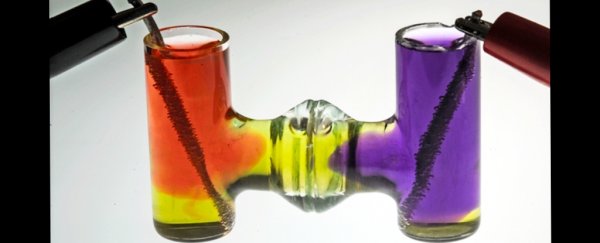Here's your dismal fact of the day: if the world's cement industry was a country, it would sit just behind China and the US as the third leading producer of carbon pollution. It doesn't need to be that way, though.
We just might be able to change that ugly statistic by producing the ingredients for this ubiquitous building material in a way that would allow for an easier capture of its emissions.
Engineers from MIT have come up with an environmentally friendly method for transforming calcium carbonate into the most widely manufactured material in the world: Portland cement.
The process for making cement currently involves crushing up limestone rocks and dumping the debris into a kiln. The pebbles are then mixed with clay and roasted to somewhere around 1,500 degrees Celsius thanks to a generous blast of heat from burning fossil fuels.
That incineration alone would pump out plenty of CO2. But the chemical reconfigurations taking place inside the kiln also release a significant amount of gas.
It all adds up to a shocking amount of carbon emissions we rarely give much thought to.
"About one kilogram of carbon dioxide is released for every kilogram of cement made today," says MIT engineer and materials scientist Yet-Ming Chiang.
Given all of the cement being poured across the land each day, our love of solid grey structures contributes around 8 percent of global greenhouse emissions.
Finding another way to loosen the bonds on the limestone's calcium carbonate so it can incorporate into the binding agent known as 'clinker' – chunks of di and tri calcium silicate mixed with some aluminate and ferrite – could potentially make for a vastly more sustainable solution.
So instead of using heat, the team turned to the chemistry of acids and bases to convert calcium carbonate into a stepping stone of calcium hydroxide.
To make this process as economical as possible, they made clever use of the way electricity can be used to split water into hydrogen and oxygen.
If you stick two electrodes into a container filled with water and run a current through it, the atomic components of H2O will divorce from one another and form hydrogen gas at one electrode, and oxygen gas at the other.
Significantly, the solution surrounding the oxygen-producing electrode will be slightly acidic, while the mix at the hydrogen-producing end will be more basic.
Throw your crushed-up limestone into this pH gradient and the calcium carbonate will react to produce bubbles of carbon dioxide at one end, and solid particles of calcium hydroxide will precipitate out at the other.
From there, turning your freshly made batch of calcium hydroxide into clinker – and the clinker into the grey powder you mix with water and sand – is a pretty straight-forward process.
Of course, you're still left with clouds of carbon dioxide billowing out of the electrochemical cell. So it's not exactly emissions-free, but this relatively clean stream of gas should be fairly easy to collect and sequester away in theory.
In any case, it's a far cry from the ugly mass of combustion fumes and toxic mess of products that traditional processes belch out.
As an added bonus, you're left with the hydrogen and oxygen from split water molecules, which can be reunited and reused, or collected for another purpose.
Essentially, the process has the potential to be cheap enough to have a hope of competing with kiln-based clinker production.
"In many geographies, renewable electricity is the lowest-cost electricity we have today, and its cost is still dropping," says Chiang.
While the team have conducted a neat proof-of-concept, they can only estimate roughly how an industrialised version might stack up.
Back-of-the-envelope calculations suggest a process like this one could amount to as little as $US35 per tonne, based on cheap electricity.
At around $US28 a tonne for cement produced the old fashioned way, this carbon-light approach isn't quite at a competitive level yet.
Chiang agrees: "It's an important first step, but not yet a fully developed solution".
Still, finding ways to make green alternatives look like a bank's best friend seems to be a common story these days.
This research was published in PNAS.
